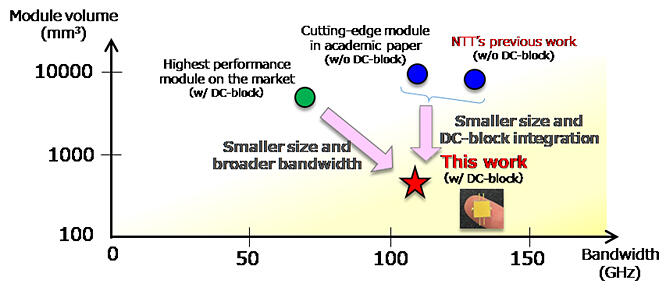On February 20, NTT announced the successful development of an ultra‐compact amplifier IC module with an ultra‐wideband performance of 100 GHz. This achievement is a significant step towards realizing next‐generation ultra‐high‐speed optical communications.
The newly developed module has successfully overcome the challenge of miniaturization, a requirement for practical use. It now boasts an ultra‐compact size of less than one‐tenth of the original size while incorporating a direct current (DC) block function to remove DC components contained in signals.
The DC block function enables direct connections to various devices, resulting in a modular device with high usability and significantly reduced cable loss. The breakthrough paves the way for practical applications.

Provided by NTT
NTT plans to apply this technology to cutting‐edge experimental and measurement equipment required to promote the research and development of next‐generation ultra‐high‐speed optical communications and 6G. It aims to put this technology to practical use as soon as possible.
In the long term, NTT plans to improve IC and packaging technologies further and explore the device's application for ultra‐high‐speed optical transmitters and receivers in innovative optical and wireless networks (IOWN). The IOWN backbone optical network that NTT aims to create is expected to require transmission speeds of more than two terabits per second per wavelength in the future.
To achieve this level of speed, it is essential to have a baseband amplifier IC module that can amplify ultra‐wideband baseband signals in the 100‐GHz class in the optical transmitter/receiver. Furthermore, there is a growing demand for ultra‐wideband and compact amplifier IC modules in the field of experimental and measuring instruments that support advanced R&D. NTT previously created a prototype of an ultra‐wideband baseband amplifier IC module with a 1mm coaxial connector. Using this technology, it has also conducted the world's first demonstration test of optical transmission exceeding two terabits per second. However, the previous prototype module was relatively large and required external DC blocking components to connect to forward and rear devices, which posed challenges regarding the module's size and usability.
The newly developed ultra‐compact baseband amplifier IC module for the 100 GHz band successfully addresses these issues. This module is the first in the world to achieve both ultra‐wideband performance of 100 GHz and integration of a DC blocking function. The enhanced performance was made possible using NTT's proprietary InPHBT (indium phosphorus hetero‐coupled bipolar transistor) technology and advances in packaging technology. This achievement marks the world's first successful integration of ultra‐wideband performance of 100 GHz and DC blocking functionality.
NTT further improved the performance of the ultra‐wideband baseband amplifier IC by utilizing its InPHBT technology, achieving broad peaking characteristics that emphasize gain on the high‐frequency side. This characteristic compensates for the loss of high‐frequency signals that occurs during packaging, ensuring gain flatness (the characteristic of obtaining a constant amplification factor from low to high frequencies) as an amplifier IC module. NTT also replaced the conventional thread‐on mating coaxial connector with a push‐on type. In addition, by designing the joint between the coaxial and the internal high‐frequency substrate, they could drastically reduce the package's size while maintaining ultra‐wideband characteristics. Moreover, NTT was able to integrate DC blocking functionality, which was previously difficult to achieve with ultra‐wideband characteristics, by mounting a small thin‐layer capacitor on the internal high‐frequency substrate through precise high‐frequency design technology.
These technologies combined have achieved an ultra‐compact size (11.8 × 10 × 4.3 cubic millimeters) that is less than one‐tenth the volume of conventional devices while achieving both ultra‐wideband characteristics of 100 GHz or higher and integrating DC blocking. NTT has also demonstrated that the amplifier IC module it has developed can amplify ultra‐wideband PAM‐4 signals with a symbol rate of 112 gigabits per second without distortion. The results were published online in IEEE Microwave and Wireless Technology Letters.
This article has been translated by JST with permission from The Science News Ltd. (https://sci-news.co.jp/). Unauthorized reproduction of the article and photographs is prohibited.




